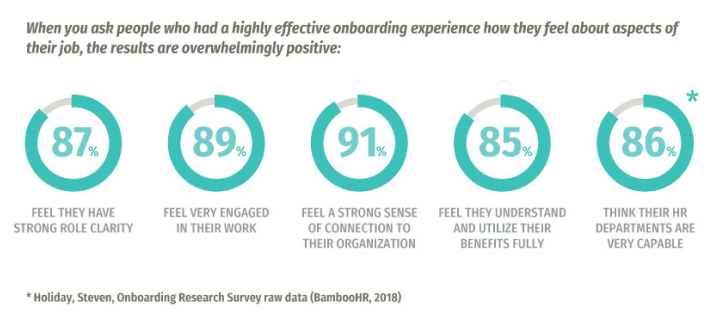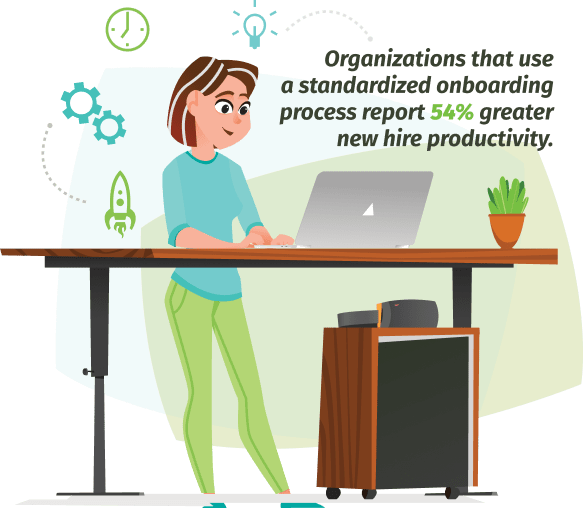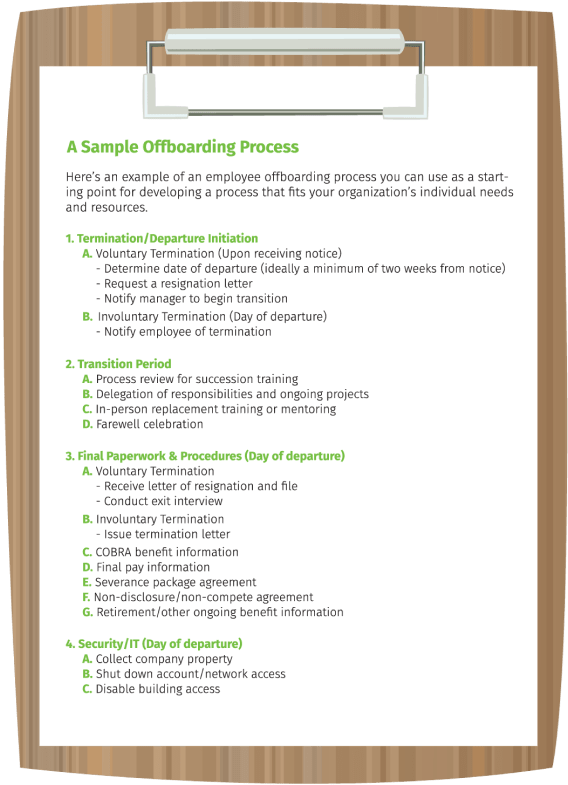Chapter 04
Onboarding & Offboarding
Employee Onboarding & Offboarding
Employee onboarding and offboarding are the bookends of the employee life cycle. That cycle begins the moment a candidate accepts your offer, and it ends on the last day they work for your organization. In between lies the bulk of the employee experience—relationships with coworkers, projects attempted and completed, successes and failures, career progression and personal growth. But as with any long-term partnership, the beginning and ending have a huge impact on the entire experience, including what happens after the relationship.
Employee onboarding and employee offboarding are critical processes that, when done effectively, can deliver probable value and a positive return on investment. Likewise, ineffective employee onboarding and offboarding can harm almost every measurable metric of an organization. Employee onboarding and offboarding deserve HR’s close attention, with careful planning, execution, and analysis to ensure they are both being done right.

What Is Onboarding and Why Is It Important?
Onboarding isn’t one thing; it’s a whole series of events and tasks designed to transform a chosen candidate into an integrated and functioning member of your organization.
Employee onboarding begins when a candidate accepts your offer, and while formal new-employee training tasks may be completed in a few days or a week, onboarding only arguably ends when the new hire is contributing at full speed—which could be months or even a year after their hire date.
That time-to-contribution variable is your first hint as to the importance of onboarding. The longer it takes for an employee to reach their expected level of performance, the longer it’s taken for your organization to realize the full return on its investment. Likewise, the more time an employee spends before they are working to their full potential, the longer they have to deal with that feeling of coming up short. The first is a direct financial outcome; the second is an emotional outcome that can cause disappointment, frustration, and disengagement—all of which can lead to financial and organizational outcomes like lost performance and higher turnover.
That’s not to say you should rush through onboarding; in fact, it means the opposite. Research shows that longer employee onboarding processes, statistically speaking, are more effective. And effective onboarding can do more than simply train new employees to meet a baseline performance level: numerous studies, including our own survey research, suggest that employees who are exposed to a highly effective onboarding process outperform those who receive poor or even adequate onboarding—not just because their time to contribution is shorter, but also because better onboarding results in lower turnover, higher engagement, and higher job satisfaction, even months and years down the road.

Why Is It Important for an Employee to Have a Good Onboarding Experience?
The first question you should be asking is, “what is a good onboarding experience?” After all, if every organization, every job, and every industry is going to have a different onboarding process, no two experiences will be alike. But while that’s true, it can also be said that every element of a good employee onboarding experience comes from a single best practice: caring about the employee.
To show how care makes a difference in the employee onboarding experience and why that matters, let’s compare two hypothetical situations: first, the experience of a junior analyst joining a major investment banking firm, and second, the experience of a newly hired summer camp counselor.
Investment Firm: The Newbie
Imagine you’re fresh out of business school and you’ve landed your dream job at a major metropolitan banking firm. You’ve recently moved to a new apartment in the city, and although you’re just a bit nervous about your first day, you show up dressed for success and ready to take on the challenge. You walk in the door, greet the HR representative, and…you’re handed a stack of paperwork as you’re shown into a big meeting room with 20 other new analysts.
You spend your first few days of your new job watching hour after hour of slickly produced corporate videos, reading thick handbooks, and filling out mountains of forms. There aren’t any group discussions or introductions; it’s up to you to introduce yourself to your new coworkers during your free lunch hours—when you’re not setting up your own workstation. You’d love to ask questions, but there aren’t any Q&A sessions. Besides, the HR representative was hired a month before you and your classmates, the videos and handbooks are all recently overhauled, and nobody seems to know anything.
At the end of the week, it’s time to begin your real job—the one you were hired to do. You show up on time (eight o’clock, right?), walk down the hall to your team’s area, and...walk right into the monthly executive update, which has been going on for an hour. Every face turns to look at you, the newbie. You’re already late, and it’s only your first day.

Summer Camp: All-Aboarding
Now, forget about the investment bank. Imagine instead you’re fresh out of high school exam week, summer break has begun, and your parents made you get a job as a counselor at the local day camp to earn money for your college fund. You’re bummed you can’t spend the summer with your friends, and you’re not exactly a fan of babysitting a bunch of little kids, so you show up on your first day dragging your feet and...you’re handed a frisbee, a new tee shirt (in your size; they sent you a questionnaire a week ago), and a book: Zen and the Art of Motorcycle Maintenance.
You spend the first week of the summer with 20 other new counselors, getting to know them all as you break out into small groups for training activities, a camp tour, interactive learning sessions, and skits produced by the senior counselors, some of whom have been there for decades. By the end of the week, you’re exhausted but excited—much more than you thought you’d be. You’ve learned all about the camp, your job, your new friends (sorry, “co-counselors”), and even a bit about yourself. When you show up on Monday for the first real day of camp, the camp director greets you by name, gives you a wink and a handshake, and asks if you’re ready, or if there’s anything you need. “I’m more than ready,” you respond, “This is going to be a great summer.”
Employees who felt their onboarding experience was effective were over 29 times more likely to feel satisfied with their jobs.
-The New Definitive Guide to Onboarding
Experience vs. Experience
Think about the similarities and differences between those two employee onboarding experiences, and then ask yourself:
- What is the outcome for the employees at either job?
- Who is better prepared for success?
- Whose expectations were met or even exceeded?
- How is that experience going to translate into their passion for the work?
- How will it impact their loyalty to the organization?
- How will it affect their personal lives?
- What’s their likelihood of recommending this place to their friends as a great place to work?
Both organizations had large groups of new hires. Both had a responsibility to deliver job and policy training. Both had time and opportunity to make new hires feel welcomed and prepared. But that’s where they begin to diverge. The camp reached out early, getting paperwork out of the way; the investment firm didn’t. The camp made learning engaging and interactive; the firm made it flashy, but flat. The camp spent time on introductions and involved veterans with years of knowledge; the investment firm spent big bucks on slick, new videos but left a new HR admin alone without any backup. And on the first day, the camp director made sure their new counselors were as ready as possible. The firm, on the other hand, clearly throws new analysts to the wolves.
Being a camp counselor is a far cry from being an investment analyst, but that’s the point: effective onboarding matters for any new employee and any role. A thoughtful, engaging, and thorough onboarding program will produce better outcomes regardless of the position, the industry, or the organization delivering it.
Those Who Care, Win
What determines the quality of a new employee’s onboarding experience? Is it about who has more money, or more time, or more information to cover?
It’s about who cares enough to make onboarding effective. The camp cares more about their new staff members’ success, and they’ve created an onboarding process that shows it: it’s fun, personal, and full of great resources that create confident new hires. If the job itself is anything like the onboarding experience, that’s the beginning of an amazing and unforgettable memory. Meanwhile, the firm has shown that it sees new hires as assets and little more. They’ve spent a ton of money on their onboarding program but not much thought, and the result is a jarring, confidence-shattering transition from onboarding to working. How will that impact the firm and their new employee in a year, or in ten years?
Care is the differentiator in employee onboarding, whether it’s at an investment bank or a summer camp. It’s not hard to imagine how onboarding affects elements like productivity, engagement, loyalty, longevity, and more—but there’s plenty of research available. When you create an onboarding program for your own organization, keep in mind that every stage is an opportunity to create an employee for life or an employee who’s already looking for the door.
What Should an HR Professional Consider When Creating an Employee Onboarding Program?
Onboarding breaks down into three general categories or periods. There’s the preboarding stage, when the new employee has accepted your offer but hasn’t seen anything of your organization beyond the application and interview process; the new-employee training stage, when new employees are introduced to company policies, benefits, and culture; and finally, the ongoing or “follow-through” stage, when they have begun working, but they are not yet fully contributing.
We’ve created an outline of some specific events and tasks associated with the three stages of the employee onboarding process. This isn’t an exhaustive or standardized list; some of these elements may be missing or in a different order depending on the industry or the organization and its specific onboarding needs. In the case of remote employee onboarding, there will be some elements that change, like a tour of the facility, but many will stay the same; they just might happen over a video call instead of in person. But this outline is a good start for anyone asking what elements to cover when creating an onboarding process.
- Preboarding Stage (Week before first day)
- —Welcome communication
- —New-hire paperwork (compliance & benefits)
- —New-hire paperwork (education & familiarization)
- New-hire Training (First week)
- —Policy training
- —Benefits training
- —Executive & team introductions
- —Additional paperwork
- —Facility tour
- Ongoing Elements & Follow-through (First week through six months)
- —On-the-job training/certification
- —New employee follow-up
- —Manager follow-up
Some organizations may follow a structure close to this one, whereas others may have a much different process in place due to industry requirements or a unique philosophy about how to welcome and train new team members. However, if there is not a formal onboarding process in place, it should be easy for you to start with the above and adapt it to your organization’s needs.
How Long Should Onboarding Take?
There’s no set-in-stone timeframe for employee onboarding, but there’s an easy way to find out what’s appropriate for your own organization: ask your new employees. New hires are the only people who go through your process, and they’re the only ones qualified to tell you whether or not it was effective. Ask them to give you feedback on what went well and where you fell short. Ask them if they had enough time to digest the information you provided, and whether they felt their training was sufficient.
And if you feel like you’re spending too much time on onboarding, just remember this: Employees at companies with the longest onboarding programs reach full speed in their new jobs about four months faster than employees who have a short onboarding experience.
“For every piece of the [onboarding] program, we’ve identified who is involved, the outcomes we are looking for, and how we can measure those outcomes. That makes it easy to launch something new, get feedback, and tweak until we start seeing the results and experiences we want.”
-Cassie Whitlock, Director of HR, BambooHR
What Is Employee Offboarding and When Does It Occur?
Offboarding is all the actions an organization deems necessary and proper in order to sever the employer-employee relationship. It occupies the time between the decision to end the employment relationship and the last interaction an employee has with their employer.
How Long Should Offboarding Take?
Like onboarding, there is no set timeline for an appropriate employee offboarding process; however, the circumstances surrounding the departure of an employee often dictate the time an employer has to complete any offboarding tasks.
What is appropriate is determined by a number of factors, including the status of the relationship, the reason for termination, the organization’s desire for a transition period, and the employee’s upcoming schedule. In the case of a voluntary termination, that may mean two weeks (the typical notice period) or more. In the case of an involuntary termination, the entire offboarding process may need to happen on the same day the decision is made.
The general consensus for offboarding employees in situations involving termination for cause seems to be the shorter, the better. This is because the risk of retaliation or an emotional or violent reaction can outweigh the benefit of gathering any feedback or preparing for the employee’s transition. The desire to minimize risk may mean that some offboarding processes occur without the employee’s knowledge so that the employee can be notified and escorted off the premises as quickly as possible.
Why Is It Important to Have an Employee Offboarding Process?
Offboarding is essential for many of the same reasons onboarding is important:
- It has a significant effect on everyone in the organization, from HR to individual teams and departments.
- It involves short- and long-term outcomes that can affect organizational health and performance.
- It’s an opportunity to strengthen your employer brand and gain insight into your organization.
Offboarding also has a bigger impact on the employee and the employer simply because it is more psychologically significant than the day-to-day routine. It’s the other bookend to the employee life cycle, and that matters.
A poor employee offboarding experience can leave an otherwise happy and engaged employee with a bad taste in their mouth and a reluctance to recommend their former workplace; conversely, a positive offboarding experience can leave a disgruntled employee—even one who was involuntarily terminated—feeling less unhappy, more optimistic about their future, and more likely to look back fondly on their time at your company.
If you think that how someone feels about your company doesn’t matter after they’re no longer your employee, consider the fact that 40 percent of employees say they would consider boomeranging back to a company where they had previously worked, and 15 percent have already done it at some point.
Employers, too, can feel the impact of employee offboarding in how the process and the experience affect HR personnel, remaining employees, and their employer brand. A good process can provide valuable insight from the departing employee, minimize the disruption for remaining staff, and improve the chances of a good review or a word-of-mouth recommendation.
On the flip side, a poorly thought out offboarding process increases the chance of mistakes and adds more stress to an already stressful event, the ripple effect of which can be felt everywhere from lost productivity to difficulty in hiring. In a market where 83 percent of surveyed job seekers said employee reviews influenced their decision to apply, one negative review can have a big impact on your hiring efforts.

Finally, having a thoughtful and consistent employee offboarding process is important because, with or without a process, there is always an employee experience, and having an offboarding process in place is the best way to ensure that experience is as positive and minimally disruptive as possible for those involved and everyone else who’s impacted.
What Should an HR Professional Consider When Creating an Employee Offboarding Process?
Offboarding tasks fall into two categories: the formal, required elements that have to happen in order for the organization to remain legally compliant, and the optional elements that fall under recommended best practices.
Legal Requirements for Compliant Employee Offboarding
Legally speaking, there are very few things an organization must do to sever ties with an employee. For the most part, it boils down to two things:
- Paying out any remaining salary or wages earned in accordance with state regulations, which may dictate when and how final payments are issued.
- Required communication about benefits like COBRA insurance, 401(k) or other retirement funds, and HSA accounts. Any employer who offers group healthcare coverage is required to notify participants and their dependents of their COBRA rights, eligibility, duration of coverage, payment expectations, and premiums.
While there are additional details involved with both tasks, such as what deductions are allowed and the timing of various types of pay, they differ from state to state and region to region. We recommend seeking advice from a legal expert in your state to ensure you are compliant.
Making relationship maintenance part of your employee offboarding process can improve engagement and loyalty in current staff, and it increases the likelihood that they will recommend you to friends and colleagues as a great employer after they leave.
Best Practices for Employee Offboarding
The bulk of most employee offboarding programs are determined not by legal requirements, but by your organization’s priorities and concerns in three main areas:
Relationship Maintenance
Relationship maintenance can be expressed as the organization’s desire to preserve a positive relationship with departing employees. This is the “feel good” part of offboarding, and the most enjoyable. It’s also where you have the greatest opportunity to remind employees (including those who are remaining on board) that you care about them and value the contributions they make.
Making relationship maintenance part of your employee offboarding process can improve engagement and loyalty in current staff, and it increases the likelihood that they will recommend you to friends and colleagues as a great employer after they leave. Relationship maintenance could take the form of a parting gift, a farewell get-together, or simply a sincere thank-you from a manager. It’s all about how you want employees to feel when they look back on their experience at your firm.
Organizational Health
Determining what elements to include in offboarding often hinges on concerns about organizational health. In employee offboarding, that means minimizing the disruption of an employee departure and gaining insights that could improve your company culture. Minimizing disruption can be as straightforward as keeping involuntary offboardings as short as possible; however, it is also any task or meeting you create to help ensure there’s no loss of productivity or knowledge. These tasks, like shadowing, redelegation of responsibilities, and redistribution of existing work, often fall to the employee’s manager, which is why it’s important to involve managers in offboarding programs.
Exit interviews also fall under the category of organizational health because they offer an opportunity to gain insights about your organization. However, exit interviews also involve some risks (covered below), which is why some organizations choose to conduct them only for voluntary terminations and others choose not to conduct them at all. If you do decide to incorporate exit interviews, it’s important to do them right in order to get the outcomes you’re seeking.
Risk Management
Risk management is arguably the most important reason to have a strong employee offboarding process, even above regulatory compliance (which is a form of risk management itself). In offboarding, risk management is anything you do to safeguard the company from a corporate security and legal liability standpoint, and it includes everything from blocking account access and disabling key cards to requiring departing employees to reaffirm a non-disclosure agreement.
Security Risk Management
Security risks vary greatly depending on industry, job roles, and responsibilities. A retail store, for example, might have very few security risk concerns outside of ensuring a former employee can’t access the store after hours or log into the POS system after they leave. Meanwhile, a large technology firm might employ extensive measures to ensure departing employees are digitally and physically locked out to prevent deleting or damaging important files and programs.
Legal Risk Management
As far as legal concerns, risk management is basically divided into two parts: preventing the loss of intellectual property and talent, and avoiding liability that could result in legal action by a terminated employee. What you do to manage these risks is often dictated by the reason for termination: a voluntary termination could involve little or no liability concerns, and therefore require little more than reminding the employee of any non-compete or non-disclosure agreements. Involuntary terminations or terminating a disgruntled employee might mean cutting off account and building access before notifying the employee, alerting your security team, having a witness present for face-to-face meetings, and even getting a lawyer to review your records and ensure you are covered against legal action.

Exit Interviews: Yes or No?
We mentioned above that there are risks involved with exit interviews, and while it may seem obvious that you would hesitate before interviewing an involuntarily terminated employee, there are some risks involved even when the separation is voluntary. An exit interview can be a good source of candid insight into your organization, revealing issues with people or processes that an employee might have been hesitant to communicate for fear of retaliation or termination. However, there is a legitimate counterpoint to conducting exit interviews. Asking exit interview questions can create tension where there wasn’t any; furthermore, what you learn may even create legal problems if an unknown issue like an allegation of harassment or illegal activity arises. So, before you start thinking up exit interview questions, ask yourself: is your organization ready and willing to properly handle the good and bad information you may gain from exit interviews?
Determining your wants and needs for relationship maintenance, organizational health, and risk management will help you decide what additional elements to incorporate into your offboarding program. From there, you can gauge the available resources you have to spend on offboarding and tune your process to deal with different situations; for example, you might have one process for when an employee is leaving for retirement, another for employees who have accepted another job, and a third for involuntary terminations for cause or due to a layoff cycle.

A Word on Consistency
As with onboarding, consistency in employee offboarding is a universal best practice. Whether it takes the form of a checklist similar to the outline above or offboarding software, it’s critical that any time you are terminating an employee they are receiving the same attention and treatment as any other employee who has left for the same reason. This is the only way to ensure that your organization is staying compliant and is addressing any safety or legal concerns, and it’s the best way to ensure you are examining and taking every opportunity to maintain good relationships with departing employees.
While terminating an employee can be a difficult or even unpleasant experience, that’s also the reason you should prepare for it with a consistent and thoughtful plan. A great offboarding program prevents unnecessary stress and balances out the negative side with positive results for your organization and your people.
You’ve read the guide. Now try the #1 HRIS for SMB, for free.
Start your Free Trial of BambooHR today!